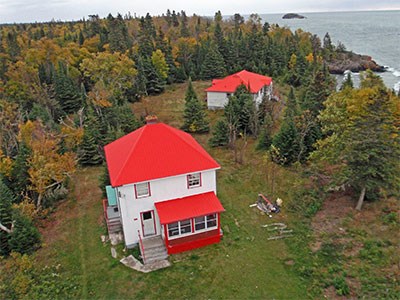A Thunder Bay preservation group believes Lake Superior lighthouses can serve as a beacon for eco-tourism.
Often located in majestic postcard settings and offering breathtaking views, Paul Morralee, secretary of Canadian Lighthouses of Lake Superior, views these windswept places as highway signposts in the nation’s cultural and marine history.
For more than a century, these wooden and steel landmarks have guided mariners through narrow channels, fog-shrouded waters, and away from hidden shoals.
“These waterways built this country. From an historical perspective, we need to manage and maintain the history of our country.”
But there’s no reason a sustainable business case can’t be had, too.
Now in its third year of existence, the 80-member group generates revenue through memberships, fundraisers and, hopefully, through fees when two properties in their care open up for overnight accommodations to boaters and kayakers this summer.
From their negotiations with the Department of Fisheries and Oceans (DFO), the group attained five-year leases on the Point Porphyry Light Station (pronounced poor-free) and Shaganash Light (Island No. 10) – both located in a cluster of islands to the southeast of Thunder Bay.
The lighthouses were automated decades ago and coast guard personnel still perform routine maintenance.
Shaganash, built in the 1920s, is a 24-foot tall fixed light marking an inside passage along the North Shore.
Last summer, volunteers applied a new coat of paint and placed a picnic table there.
Porphyry is the more spectacular of the two.
The original lighthouse was replaced with a steel skeletal tower in the 1960s, but the property holds two dwellings and mechanical and foghorn buildings, painted white with red roofs.
With a helicopter landing pad, it offers a rare lakeside view of the Sleeping Giant peninsula.
Over time, the buildings had fallen victim to vandalism before volunteers began trimming trees, brushing out trails, painting the buildings and replacing windows last summer.
Morralee believes these properties can be economic development engines to showcase the North Shore’s natural beauty and offer unique wilderness experiences to international tourists.
Heritage Canada recognizes the value of lighthouses to attract tourists and anchor regional identity. The national charity is lobbying for federal funding to be made available for groups to readapt these historic relics for new uses.
“What stands out in my mind is the economic diversity that one lighthouse can offer,” said Morralee, a boating enthusiast and professional videographer.
His group has joined forces with Tourism Thunder Bay and local sailing and float plane charter companies to promote and arrange special excursions for hiking, picnicking, birding, historical interpretative tours or for tourists to simply commune with nature.
Armed with a $52,000 budget, volunteers are planning more care and maintenance work with painting, cleaning, repairs to wooden docks and stairs, and capital improvements by introducing some ’60s-’70s era furniture.
With the relationship they’ve carefully fostered with DFO, Morralee said they’re close to having full ownership at Shaganash and Porphyry, with the possibility of leasing two more properties.


.jpg;w=120;h=80;mode=crop)

